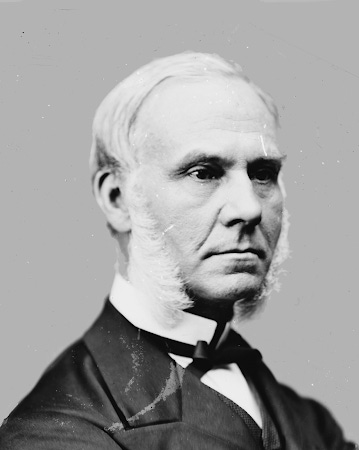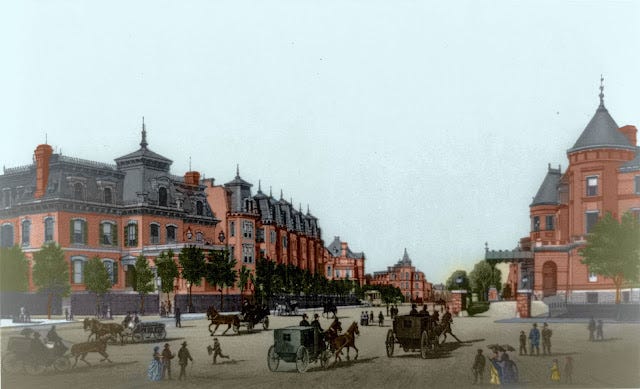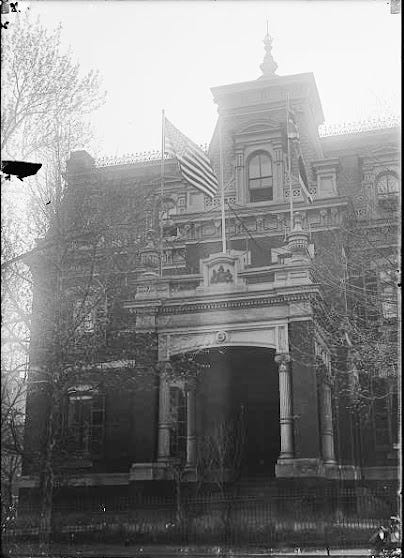The British Are Coming: The British Legation Moves to Connecticut Avenue
Although William Stewart and Curtis Hillyer had already built their mansions as a statement of the future respectability of Dupont Circle, it was not until the arrival of the British Legation in the southern part of the neighborhood that the area north of Shepherd’s Row would finally start to be viewed as a desirable location.
With the increase in the importance of Washington, DC, both as the center of the federal government and as a town growing in global political and cultural influence after the Civil War, Britain’s minister to the United States since 1867, Sir Edward Norton, believed that it was now imperative to have an impressive and permanent legation building in Washington.
The British Legation had been leasing a house at 1525 H Street Northwest just to the east of St. John’s Episcopal Church on Lafayette Square. The Prussian government had already purchased its own legation building on Fifteenth Street, but as a new legation building for the British it would be the first foreign investment in new construction in the city.

In May 1873, realtor Matthew Latta sold Sir Edward a large parcel of land on the corner of N Street and Connecticut Avenue that was held by the Pacific Syndicate. The British government paid the astonishingly high price of fifty-five cents a square foot in an area of the city that many considered an unacceptable location for such an important building as the British Legation.
Scottish-born American architect John Fraser from Philadelphia was contracted to build the large Second Empire–style legation building at 1300 Connecticut Avenue, bordering on the northwest side of N Street. On Christmas Day 1873, New York’s Illustrated Newspaper wrote, “Sir Edward Thornton is now building a magnificent mansion in the English style. It…will be, when completed, the most substantial building in Washington.” Construction began in late 1873, and the stately building was ready for occupancy early the following summer; however, Sir Edward would not take up residence himself in the new building until 1876. The new legation was often referred to as the “second most famous residence in Washington” and jokingly as “1600 Connecticut Avenue.”
Topped by a gray slate mansard roof, the entrance to the building was reached from under an imposing porte-cochère on Connecticut Avenue that was dominated by the British coat of arms. Past the outer vestibule, a second interior vestibule had heavy mahogany doors, the inner ones decorated with heavy bas-relief and brass knobs. When the doors were opened, visitors were greeted by an impressive and imposing staircase with a portrait of Queen Victoria in her coronation robes at the head of the landing.
Yet when it was first built, the new British Legation building did not attract much development along Connecticut Avenue. The city was still under the shadow of the Long Depression, and property values remained depressed and there was little new construction anywhere in the city.
When Sir Edward was appointed as ambassador to St. Petersburg in 1881, many of the household goods that he left behind were sold at a public auction. Crowds poured in early on the day of the auction, not so much to inspect the items before the sale as to see the interior of the mansion. They ended up being very disappointed as all items to be sold were grouped in the ballroom with the entrance only by a side door and hall, thus cutting off other ingresses or the potential to wander off to see other parts of the house.
For many years the British Legation, which was the first official embassy in Washington, was the epicenter of social life in the neighborhood. Many evenings, the streets near the building were filled with curious crowds who assembled to watch the long line of carriages rolling up to the door and discharging eminent men and women invited to attend one function or another. In 1893, the Infanta Eulalia of Spain and her husband were entertained at the legation. The Prince of Wales, while staying at the home of Perry Belmont on New Hampshire Avenue, was a guest at a formal dinner in 1919. The embassy became a society objective of almost unparalleled rank. To have been a guest there was to have finally been accepted and “approved” as entitled to the highest social consideration. It was even a higher honor to have the British minister or high-ranking legation staff attend one’s own social functions.
By 1928, the old British Legation building, along with the other buildings along the southern stretch of Connecticut Avenue, began to yield to the pressures of commercial expansion. In 1892, the restaurant Maison Rauscher, sometimes called the “Delmonico’s of Washington,” opened on the southwest corner of Connecticut Avenue and L Street, and from there began a slow and steady crawl of commercial development up the avenue.
In 1928, British ambassador Sir Esme Howard laid the corner stone for the new embassy and chancery farther out on Massachusetts Avenue. In 1931, when the embassy staff had totally relocated to the new complex, the wrecking ball took down the old legation building. In a course of less than sixty years, what was once considered the most prime piece of real estate in the city, as well as its social center for so long, became a parking lot.









